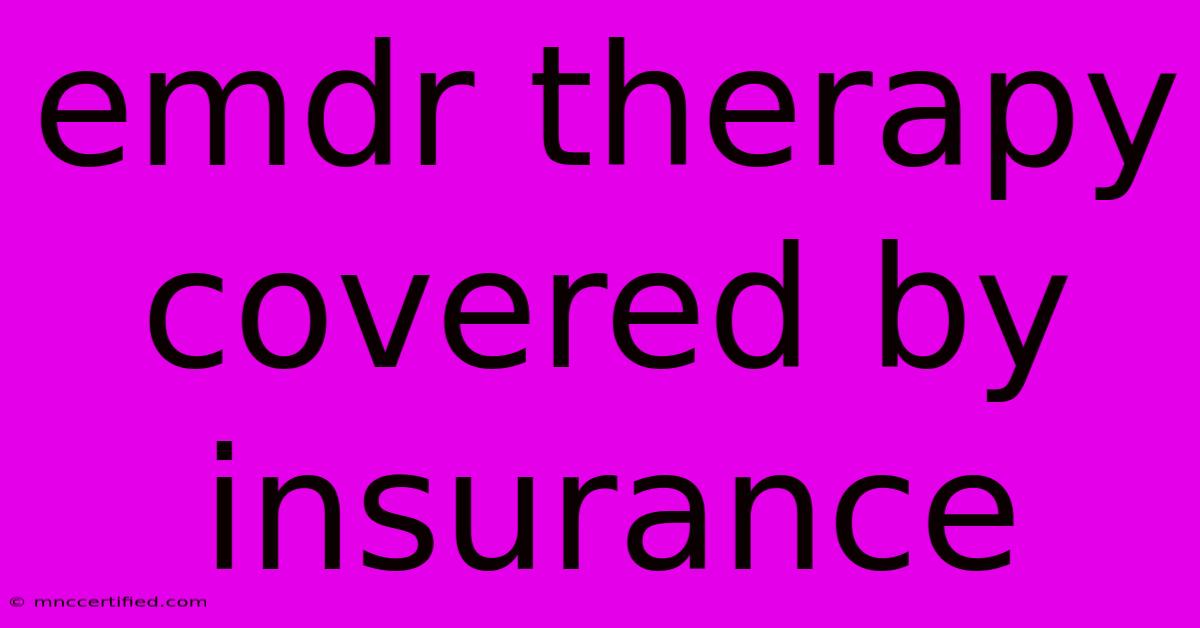Emdr Therapy Covered By Insurance

Table of Contents
Is EMDR Therapy Covered by Insurance? A Comprehensive Guide
Eye Movement Desensitization and Reprocessing (EMDR) therapy is a powerful treatment for trauma and PTSD, but the cost can be a significant barrier for many. Understanding your insurance coverage is crucial before starting EMDR therapy. This guide will help you navigate the complexities of insurance coverage for EMDR and empower you to make informed decisions about your mental health care.
Understanding Your Insurance Plan
The first step in determining whether your insurance covers EMDR therapy is to thoroughly review your policy documents. Look for keywords like "mental health services," "psychotherapy," "outpatient therapy," and "trauma treatment." While some plans explicitly list EMDR, others may cover it under broader categories.
Key Questions to Ask Your Insurance Provider:
- Does my plan cover mental health services? This is the most fundamental question. If the answer is no, EMDR is unlikely to be covered.
- What is my plan's coverage for outpatient psychotherapy? EMDR is typically considered outpatient therapy.
- Is EMDR therapy specifically covered under my plan? If not, ask if similar therapies, like trauma-focused CBT or PTSD treatment, are covered. This might indicate potential coverage for EMDR.
- What is my deductible? You'll need to meet your deductible before your insurance begins to cover services.
- What is my copay or coinsurance? This is the amount you'll pay per session after meeting your deductible.
- Do I need a referral from my primary care physician (PCP)? Some plans require a referral for mental health services.
- What is the process for pre-authorization or pre-certification? Many insurance companies require this step before they'll cover EMDR. Failing to obtain pre-authorization can lead to denied claims.
- What is the provider network? Ensure your chosen EMDR therapist is in your insurance plan's network to maximize coverage. Out-of-network providers often result in significantly higher out-of-pocket costs.
Factors Affecting EMDR Insurance Coverage
Several factors influence whether your insurance will cover EMDR:
- Your specific insurance plan: Coverage varies greatly between insurance companies and even within plans offered by the same company.
- Your therapist's credentials: Ensuring your therapist is a licensed mental health professional is crucial for insurance coverage. Check if they are specifically trained and certified in EMDR.
- Your diagnosis: A formal diagnosis, such as PTSD or another trauma-related disorder, is often required for insurance to cover EMDR therapy. Your therapist will help determine the appropriate diagnosis.
- Geographic location: Coverage policies can differ depending on your state or region.
Tips for Maximizing Your EMDR Insurance Coverage
- Contact your insurance provider directly: Don't rely solely on online information. Contact your insurer's customer service directly to clarify coverage specifics.
- Ask your therapist about insurance: Many therapists are well-versed in insurance procedures and can help you navigate the process.
- Keep detailed records: Maintain thorough records of your sessions and any communication with your insurance company. This is crucial for resolving any billing disputes.
- Explore alternative payment options: If EMDR isn't fully covered, investigate options like payment plans, sliding scales, or financial aid programs offered by your therapist or community organizations.
Finding EMDR Therapists in Your Network
Finding an EMDR therapist within your insurance network is critical. Most insurance companies offer online provider directories on their websites. You can also use online search engines, specifying "EMDR therapist" and your insurance provider to narrow your search. Always verify coverage with both your insurer and the therapist before scheduling an appointment.
By understanding your insurance plan and following these tips, you can increase your chances of accessing affordable and effective EMDR therapy. Remember, advocating for your mental health is important, and understanding your insurance coverage is a significant part of that process.

Thank you for visiting our website wich cover about Emdr Therapy Covered By Insurance. We hope the information provided has been useful to you. Feel free to contact us if you have any questions or need further assistance. See you next time and dont miss to bookmark.
Featured Posts
-
Nations League Croatia Ties Portugal Advances
Nov 19, 2024
-
Actor Paul Teal One Tree Hill Dies At 35
Nov 19, 2024
-
Paul Teal One Tree Hill Actor Passes Away At 35
Nov 19, 2024
-
Trump Dance Trend In American Sports
Nov 19, 2024
-
Are Cadillacs Expensive To Insure
Nov 19, 2024